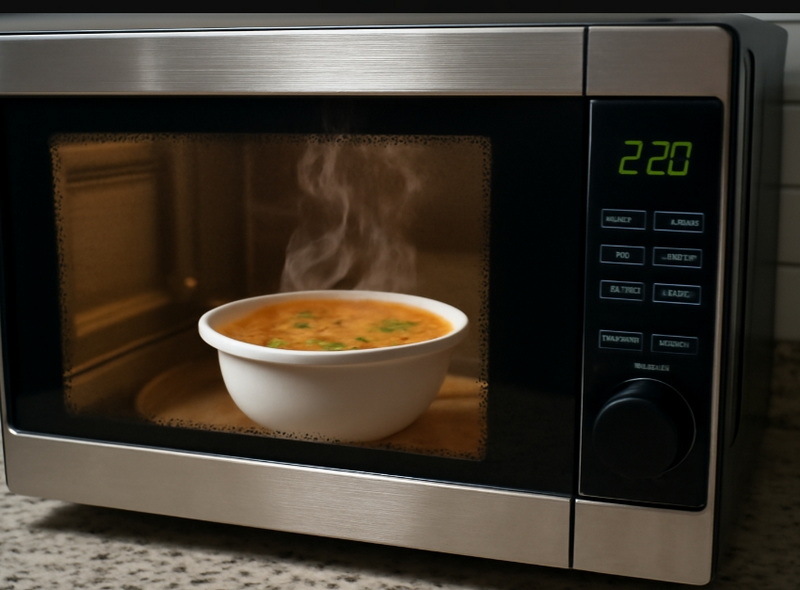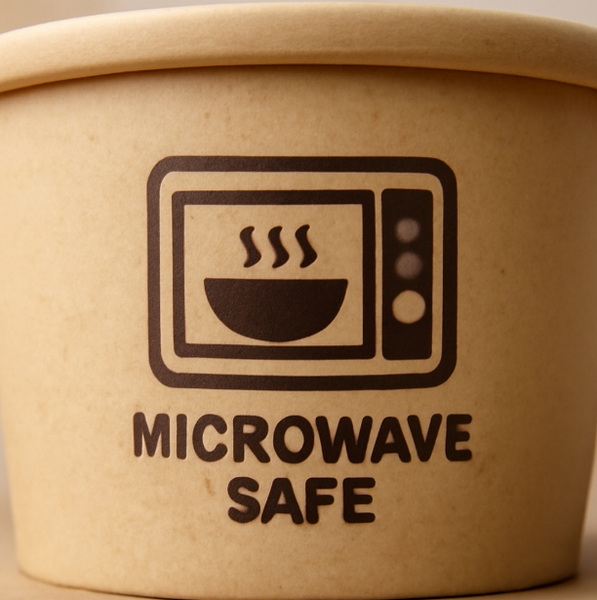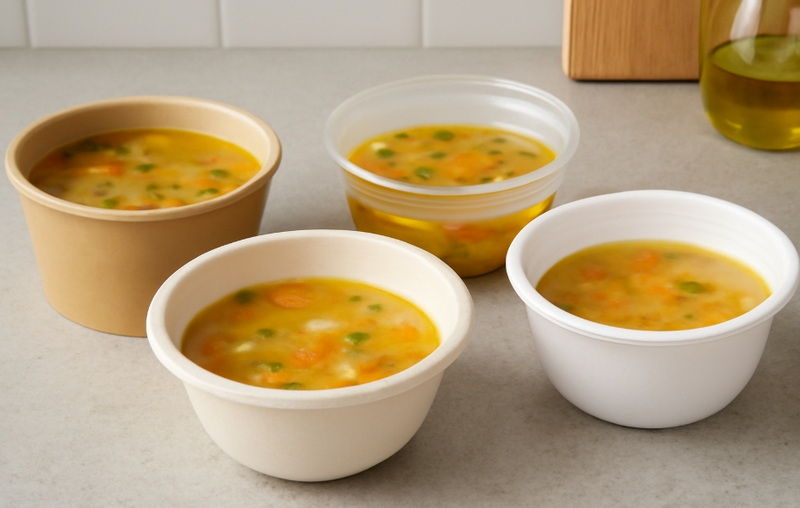
Content Menu
● Understanding Disposable Bowls for Soup
>> Types of Disposable Bowls for Soup
● How Microwaves Interact with Disposable Bowls
>> The Role of Coatings
● Microwave Safety: What the Data Reveals
>> Key Findings
>> Regulatory Standards
● Risks of Microwaving Soup in the Wrong Disposable Bowl
● Best Practices for Microwaving Soup in Disposable Bowls
>> 1. Check for Microwave-Safe Labeling
>> 2. Know Your Coating
>> 3. Use Double-Wall or Reinforced Bowls
>> 4. Avoid Overheating
>> 5. Remove or Vent the Lid
>> 6. Monitor and Handle with Care
● Choosing the Best Disposable Bowl for Soup
● Conclusion
● FAQ
>> 1. How can I tell if a disposable bowl for soup is microwave-safe?
>> 2. What happens if I microwave soup in a non-microwave-safe disposable bowl for soup?
>> 3. Can I microwave soup in plastic disposable bowls for soup?
>> 4. Should I cover my soup when microwaving in a disposable bowl for soup?
>> 5. Are biodegradable disposable bowls for soup safe in the microwave?
Microwaving soup is a daily convenience for many, especially in a fast-paced world where disposable bowls for soup have become a staple in homes, offices, and restaurants. But a common question arises: Is it safe to microwave soup in disposable bowls? The answer depends on the type of disposable bowl, its material, and how you use it. This comprehensive guide explores the science, safety, and best practices for microwaving soup in disposable bowls for soup, ensuring your meal is both quick and safe.

Understanding Disposable Bowls for Soup
Disposable bowls for soup are designed for single-use convenience, often made from paper, plastic, or biodegradable materials. Their popularity stems from their lightweight nature, cost-effectiveness, and the elimination of dishwashing. However, not every disposable bowl for soup is created equal—especially when it comes to microwave safety.
Types of Disposable Bowls for Soup
- Paper Bowls: Typically coated with a thin layer of plastic (such as PE, PLA, or PP) to prevent leaks.
- Plastic Bowls: Made from various plastics, including polypropylene (PP), polystyrene (PS), or polyethylene (PE).
- Biodegradable Bowls: Crafted from materials like sugarcane bagasse or cornstarch, often marketed as eco-friendly alternatives.
Each type offers different levels of microwave safety, which is crucial when reheating or cooking soup.
How Microwaves Interact with Disposable Bowls
Microwaves heat food by causing water molecules to vibrate, generating heat quickly. This process can also heat the bowl itself, especially if the material is not designed to withstand high temperatures. The coating or lining inside a disposable bowl for soup plays a pivotal role in determining whether it can safely handle microwave heat.
The Role of Coatings
- PE (Polyethylene) Coating: Common in inexpensive paper bowls, but softens and may leach chemicals at higher temperatures. Not ideal for microwaving hot soup.
- PLA (Polylactic Acid) Coating: Plant-based and more heat-resistant, tolerating higher temperatures, suitable for short microwave sessions.
- PP (Polypropylene) Coating: The most microwave-friendly, withstanding higher temperatures, making it the safest for hot soup and longer heating times.
Microwave Safety: What the Data Reveals
Not all disposable bowls for soup are microwave-safe. Laboratory tests and regulatory guidelines highlight the importance of bowl structure, coating, and labeling.
Key Findings
- Single-wall PE-lined bowls: Prone to warping and minor leakage after several minutes of microwaving.
- Double-wall or reinforced bowls: Offer better insulation, structural integrity, and leak resistance.
- Kraft paper and bagasse bowls: Withstand higher temperatures without leaking or structural failure.
Regulatory Standards
- FDA (U.S.): Permits microwave use of food-grade paperboard coatings if labeled “microwave safe.”
- EU Regulations: Restrict chemical migration from packaging into food at high temperatures.
Risks of Microwaving Soup in the Wrong Disposable Bowl
Using the wrong disposable bowl for soup in the microwave can lead to several issues:
- Bowl Collapse: Weak or thin bowls may sag or break, causing spills and burns.
- Chemical Leaching: Non-microwave-safe coatings can release harmful substances into your soup, posing health risks.
- Microwave Damage: Melting plastic or coatings can adhere to the microwave interior, causing permanent damage.
- Food Contamination: Inks, adhesives, or fluorescent agents used in some bowls may migrate into food when heated.

Best Practices for Microwaving Soup in Disposable Bowls
To safely microwave soup in a disposable bowl for soup, follow these guidelines:
1. Check for Microwave-Safe Labeling
Always use bowls clearly marked as “microwave-safe.” If the packaging lacks this information, consult the supplier or manufacturer for heat resistance certifications.
2. Know Your Coating
- Prefer PP-coated or PLA-coated paper bowls for soup.
- Avoid PE-coated bowls for extended or high-temperature microwaving.
3. Use Double-Wall or Reinforced Bowls
For hot soups or prolonged heating, choose double-wall or reinforced disposable bowls for soup to prevent warping and spills.
4. Avoid Overheating
- Heat soup in short intervals, stirring between cycles.
- Avoid microwaving for extended periods at high power, even in microwave-safe bowls.
5. Remove or Vent the Lid
Never microwave soup with a tightly sealed lid. Either remove the lid or use one with steam vents to prevent pressure buildup, which can cause the bowl to burst.
6. Monitor and Handle with Care
After microwaving, let the bowl stand for a minute to allow heat to distribute evenly. Use oven mitts or a towel, as the bowl may be hot.
Choosing the Best Disposable Bowl for Soup
When selecting a disposable bowl for soup for microwave use, consider the following options:
| Bowl Type | Material/Coating | Microwave Safety | Best Use Case |
| Sugarcane Bagasse Bowl | Biodegradable fiber | Excellent | Eco-friendly, hot soup |
| Cornstarch Bowl | Biodegradable starch | Good | Light, hot soup |
| Paper Bowl (PP/PLA) | Food-grade PP/PLA | Excellent | Takeout, family use |
| Double-Wall Paper Bowl | Reinforced paper/PP | Excellent | Large, hot servings |
| PP Plastic Bowl | Polypropylene (PP) | Excellent | Office, takeout, home |
Always confirm the presence of a “microwave safe” symbol or certification before use.
Conclusion
Microwaving soup in a disposable bowl for soup is safe—provided you use the right type of bowl. Always choose bowls specifically labeled as “microwave-safe,” preferably those made from PP, PLA, sugarcane bagasse, or reinforced paper. Avoid bowls with PE coatings for high heat or long durations, and never microwave with a tightly sealed lid. By following these best practices, you can enjoy the convenience of disposable bowls for soup without compromising your health or safety.

FAQ
1. How can I tell if a disposable bowl for soup is microwave-safe?
Look for a “microwave-safe” label on the packaging or bottom of the bowl. If in doubt, ask your supplier or manufacturer for certification. You can also test by microwaving a bowl filled with water for one minute—if the bowl remains cool and the water heats up, it is likely safe for microwave use.
2. What happens if I microwave soup in a non-microwave-safe disposable bowl for soup?
Using the wrong bowl can cause it to collapse, leak, or release harmful chemicals into your soup. This not only ruins your meal but may also pose health risks and damage your microwave.
3. Can I microwave soup in plastic disposable bowls for soup?
Only if the bowl is made from microwave-safe plastic, such as polypropylene (PP), and is labeled accordingly. Avoid plastics like polystyrene or any bowl without a microwave-safe symbol.
4. Should I cover my soup when microwaving in a disposable bowl for soup?
Yes, but do not seal the lid tightly. Use a vented lid or cover the bowl loosely with a paper towel to prevent splatters while allowing steam to escape, reducing the risk of pressure buildup and spills.
5. Are biodegradable disposable bowls for soup safe in the microwave?
Many biodegradable bowls made from sugarcane bagasse or cornstarch are microwave-safe, but always check for the “microwave-safe” label. These bowls are generally heat-resistant and eco-friendly, making them a good choice for hot soup.

















